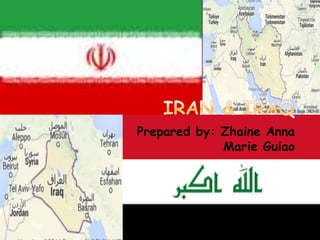
Iran and Iraq
- 1. Prepared by: Zhaine Anna Marie Guiao
- 2. 18th largest country in the world 17th nation with the most population with 78.4 million people living Home to one of the world’s oldest civilizations Tehran, the capital city, serves as cultural, commercial, and industrial center of the nation. Have the largest gas supply in the world Have large reserves of fossil fuels
- 3. Size is almost the same when United Kingdom, France, Spain, and Germany were combined One of the world’s most mountainous nations Its landscape dominated by rugged mountain ranges that separate various plateaus from one another Mount Damavand – highest point in Iran and highest mountain on the Eurasian landmass west of the Hindu Kush Northern part of the country is covered by dense rain forests called Shomal The eastern part of Iran is made mostly of desert basins and some salt lakes Mount Damavand
- 5. Changes from arid or semiarid to subtropical along the Caspian coast and the northern forests The temperature rarely falls below freezing and stays humid for the rest of the year in the northern edge of Iran Annual precipitation is 680 mm in the eastern part of the plain and more than 1,700 mm in the western part. The western part experiences lower temperature; the east and central basins are arid
- 6. Major crops of Iran are wheat, rice, and barley Others are sugar, pistachio, saffron, tea, and fruits More than 2000 plant species grow in Iran It is possible to cultivate a diverse variety of crops because of: - the wide range of temperature fluctuation - multiplicity of climatic zones
- 7. Sheep are by far the most numerous, followed by goats, cattle, donkey, horses, water buffalo, and mules. The raising of poultry for eggs and meat is prevalent Iran has also a large dairy industry and imported close to close to two million tons of feed grain annually in 2006 It is forbidden to raise pigs in Iran
- 8. Baghdad – largest and capital city of Iraq Located in West Asia Has a narrow section of coastline measuring 58km on the northern Persian Gulf Home to continuous successive civilizations since the 6th millennium BC Iraq was placed under the authority of the United Kingdom as the British Mandate of Mesopotamia Iraq was controlled by the Arab Socialist Ba'ath Party from 1968 until 2003
- 9. It is the 58th largest country in the world Mainly consists of desert but near the two major rivers are fertile alluvial plains North of Iraq is made up of mountains Size is comparable to the US state of California, and somewhat larger than Paraguay
- 10. Most of the parts of Iraq has arid climate with subtropical influence In summer, Iraq has a temperature above 40°C in most of the country and often exceeds 48°C Winter temperatures rarely exceed 21°C with a maximum roughly 15°C to 19°C Precipitation in the country is low Rainfall during the summer is extremely rare, except in the far north of the country Northern mountainous regions have cold winters with occasional heavy snows, sometimes causing extensive flooding
- 11. Iraq experienced financial problems in the 1980s Iraq suffered from economic losses In 1988, oil exports gradually increased with the construction of new pipelines and restoration of damaged facilities Inflation has decreased consistently since 2006 as the security situation has improved
- 12. Iraq is a net food importer despite of its abundant land and water resources Iraq imported large quantities of grains, meat, poultry, and dairy products under the UN Oil for Food Program The government abolished its farm collectivization program in 1981 Their most important crop is grain (wheat and barley)
- 13. Officially the Islamic Republic of Iran Have the world’s largest gas supply Capital city is Tehran 18th largest country Mount Damavand – highest point in Iran One of world’s most mountainous country Climate is arid or semiarid to subtropical Major crops: Wheat, rice, and barley Sheep are the most numerous raised animals
- 14. Officially the Republic of Iraq Capital city is Baghdad 58th largest country Climate is arid with subtropical influence Have low precipitation Oil exports gradually increased in 1988 A net food importer Most important crop is grain
